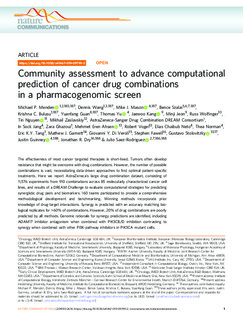| dc.contributor.author | Kuiper, Martin | |
| dc.contributor.author | Lægreid, Astrid | |
| dc.contributor.author | Flobak, Åsmund | |
| dc.contributor.author | Thommesen, Liv | |
| dc.contributor.author | Team, Dream | |
| dc.date.accessioned | 2020-01-16T10:23:55Z | |
| dc.date.available | 2020-01-16T10:23:55Z | |
| dc.date.created | 2020-01-15T07:38:43Z | |
| dc.date.issued | 2019 | |
| dc.identifier.issn | 2041-1723 | |
| dc.identifier.uri | http://hdl.handle.net/11250/2636615 | |
| dc.description.abstract | The effectiveness of most cancer targeted therapies is short-lived. Tumors often developresistance that might be overcome with drug combinations. However, the number of possiblecombinations is vast, necessitating data-driven approaches tofind optimal patient-specifictreatments. Here we report AstraZeneca’s large drug combination dataset, consisting of11,576 experiments from 910 combinations across 85 molecularly characterized cancer celllines, and results of a DREAM Challenge to evaluate computational strategies for predictingsynergistic drug pairs and biomarkers. 160 teams participated to provide a comprehensivemethodological development and benchmarking. Winning methods incorporate priorknowledge of drug-target interactions. Synergy is predicted with an accuracy matching bio-logical replicates for >60% of combinations. However, 20% of drug combinations are poorlypredicted by all methods. Genomic rationale for synergy predictions are identified, includingADAM17 inhibitor antagonism when combined with PIK3CB/D inhibition contrasting tosynergy when combined with other PI3K-pathway inhibitors in PIK3CA mutant cells. | nb_NO |
| dc.language.iso | eng | nb_NO |
| dc.publisher | Nature Research | nb_NO |
| dc.rights | Navngivelse 4.0 Internasjonal | * |
| dc.rights.uri | http://creativecommons.org/licenses/by/4.0/deed.no | * |
| dc.title | Community assessment to advance computational prediction of cancer drug combinations in a pharmacogenomic screen | nb_NO |
| dc.type | Journal article | nb_NO |
| dc.type | Peer reviewed | nb_NO |
| dc.description.version | publishedVersion | nb_NO |
| dc.source.volume | 10 | nb_NO |
| dc.source.journal | Nature Communications | nb_NO |
| dc.source.issue | 2674 | nb_NO |
| dc.identifier.doi | 10.1038/s41467-019-09799-2 | |
| dc.identifier.cristin | 1773234 | |
| dc.description.localcode | This article is licensed under a Creative CommonsAttribution 4.0 International License, which permits use, sharing,adaptation, distribution and reproduction in any medium or format, as long as you give appropriate credit to the original author(s) and the source, provide a link to the CreativeCommons license, and indicate if changes were made. The images or other third partymaterial in this article are included in the article’s Creative Commons license, unlessindicated otherwise in a credit line to the material. If material is not included in thearticle’s Creative Commons license and your intended use is not permitted by statutoryregulation or exceeds the permitted use, you will need to obtain permission directly fromthe copyright holder. To view a copy of this license, visithttp://creativecommons.org/licenses/by/4.0/ DOI: 10.1038/s41467-019-09799-2 | nb_NO |
| cristin.unitcode | 194,66,10,0 | |
| cristin.unitcode | 194,65,15,0 | |
| cristin.unitcode | 194,66,40,0 | |
| cristin.unitname | Institutt for biologi | |
| cristin.unitname | Institutt for klinisk og molekylær medisin | |
| cristin.unitname | Institutt for bioingeniørfag | |
| cristin.ispublished | true | |
| cristin.fulltext | original | |
| cristin.qualitycode | 2 | |

